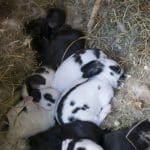Rabbit Breeds, Basic Rabbit Care & Interesting Rabbit Facts

Rabbits are easy to care for because they take up very little space, make no noise and won’t disturb neighbors. We’ll discuss rabbit breeds, basic rabbit care, and some interesting rabbit facts.
There are four basic rabbit colors – black, blue, chocolate, and lilac. Within these colors, there are different mixes and patterns, and fur textures.
To make it easier to choose the best rabbit breeds, I like to put them into three categories.
The best pet rabbits breeds include:
These rabbit breeds are best-suited as pets. They are small, cute and easy to take care of. Pet rabbits are perfect for a young child to learn some responsibility or to display at a 4H show.
Their waste makes a wonderful addition to a garden or the compost pile. A breeding pair may cost around $25-30, and they require about 2 ounces of food per day.
Pet rabbits are the third most common animal to end up in shelters, behind dogs and cats. Please be certain that you really want a pet bunny before you make the commitment. House rabbits may also chew on things they shouldn’t, like electrical cords. Be careful when your rabbit is out of its cage.
The best meat rabbit breeds include:
These homestead rabbits are very large, especially compared to “pet” breeds, so they eat considerably more food and hay. The average rabbit can easily weigh 3-4 lbs once processed.
These rabbits have litters of 9-12 kits at a time. This means one breeding pair can easily sustain a family with plenty of alternative protein. A good breeding pair can cost around $50 to start up. They can require about 5-6 ounces of food per day.
See “Meat Rabbits – What You Need to Know” for more information.
Homestead fiber rabbit breeds include:
Chinese Angoras are very rare in America, so the best bet would be finding French or English Angoras. They are a large breed, and one full grown rabbit can easily produce a pound of fiber twice a year.
If you are looking for a steady source of yarn to spin and craft, this is the breed for you. They are also a great meat rabbit, and their dual purpose makes them an ideal start for a homesteader. The only drawback is the initial cost.
A good breeding pair of Angora rabbits may cost up to $300 to start. Angora rabbits will typically live for 9 to 12 years. These rabbits will usually require about 4-5 ounces of food per day.
For more detailed information on recognized breeds for show rabbits, you can visit the American Rabbit Breeders Association.
Whatever rabbit breed you choose, you will need a few things to start. Rabbits need a cage, water bottle, a food crock or bowl, hay, and food. Small toys or wooden chews are also nice.
The other thing that all rabbits need, especially the larger breeds, is a resting board. Rabbits need to get off the hard wire of the cage once in a while, otherwise they may develop sore hocks. They sell resting boards at the pet supply stores, or they are sometimes included with the cage. You can also use an old scrap of carpet or a piece of toweling.
During extreme cold temperatures, it’s best to have two or more water bottles per rabbit. That way you can make chores easier as you can just swap the bottles for a non frozen one.
They also have heated water bottles, but they can get very expensive quickly. I have never found one that lasts longer than one season.
You will also want to make sure they get some extra hay and food to help keep them warm. (Rabbits naturally burn extra calories to keep warm, just like humans.)
When it’s extremely hot outside, you can place a frozen water bottle in the cage. This will allow the rabbit to “cuddle” up to it and help keep cool.
We also use ceramic tiles that we freeze for the rabbits to lay on as well in the summer. A fan blowing in their rabbitry will keep the air moving for them, and help them stay cool.
Wild rabbits generally live for 1-2 years. Domestic pet rabbits can live up to 8 to 12 years.
No, rabbits are crepuscular, which means they are most active at dawn and dusk. Rabbits will sleep during the day and at night. They can sleep with their eyes open, which is a little strange and disconcerting.
Yes, rabbits will eat some of their own droppings. There are two types of rabbit poop, and rabbits sometimes eat their soft night droppings.
It’s important for rabbits to have tough things to gnaw on, to wear down their teeth. Safe branches and twigs work best. (See “What do Rabbits Eat?” for suggestions.)
Pet rabbits or breeding rabbits with limited space in their runs will likely need their nails trimmed as they get older. Trim nails roughly every six weeks.
Easy care and useful for compost, meat, or fiber, rabbits can be a great addition to a small homestead.
What rabbit breed do you prefer? Leave a comment and share your experience below.
This is a guest post by Heather Harris. She and her family live in Northern Indiana, where they enjoy raising a garden, rabbits and assorted poultry in their backyard.
You may also enjoy other Homesteading articles, such as:
Originally published in 2014, last updated in 2023.
It makes a HUGE difference when you share our articles. Thank you so much!
